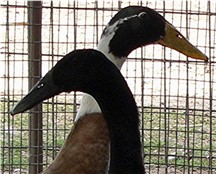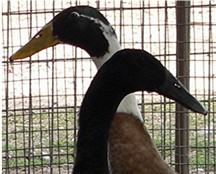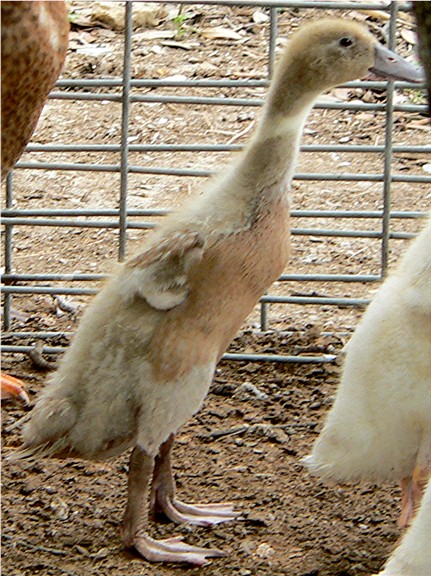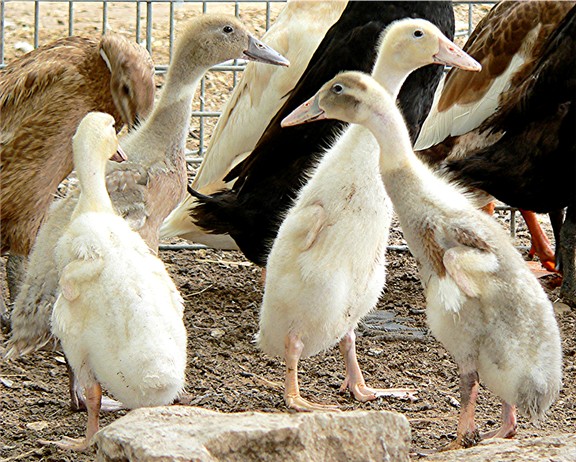

Assorted Indian Runner Ducks
Egg Laying Ducks at Lucky Hit Ranch


|
 Assorted Indian Runner Ducks Egg Laying Ducks at Lucky Hit Ranch |

|
 and Phone Numbers Link
and Phone Numbers Link
|
|
|
Link to Standard Colors of the Indian Runner Duck from the British Waterfowl Association's Indian Runner Standards Review held between February and May 2006 |
|
These pictures show some Indian Runner ducklings in the process of shedding their baby fuzz. | |
One month old ducking shedding baby fuzz.
| |
One month old duckings shedding baby fuzz.
| |
|
As cute as these Indian Runner babies are in a still picture, they are even more delightful to watch in person. I love providing them fresh water to play in, as they seem full of joy playing in clean, fresh water. |
| Link to MY UNDERSTANDING of PLUME COLOR GENETICS for INDIAN RUNNER DUCKS |
|
I received an email dated April 2, 2010, from J.M.Thompson stating "Please
excuse my forthrightness in pointing out that you copy one of Ashton's errors
in stating Prof. Rudolph obtained records of the Penguin Duck's arrival
at the 'Surrey Zoological Gardens'. I advised her of this error some time ago,
but the error persists. It is the London Zoological Gardens that the records
relate to. The two establishements were quite seperate." Mr. Thompson included an attached file, dated 31st March, 2010, which states.... Dear Erick, I have read, with interest, your most comprehensive web-page accounts on the Indian Runner Duck & the Pilgrim Goose. I have been in correspondence with Prof. Wolfgang Rudolph for over 28 years now. In the late 1970’s I commenced sending him copies of articles & books that were not available to him in Rostock ~ as it was then behind the Iron Curtain. I recall how he questioned the date of the second edition Willughby (1678) I had sent, & was even more surprised to be informed of the first edition – Latin text – of 1676. Wolfgang & I have always had a great fascination with the Indian Runner & Pekin ducks, & are not completely satisfied with all that has been written about their histories ~ not that there is any fault with your texts. You may be interested to know that Penguin Ducks are mentioned in the popular British Press in 1837. 1838 was a good year for the Penguin Duck as Eyton mentions it in his monograph. Heinrich Zollinger first wrote of the ducks in a publication of 1847 ~ the 1851 copy often cited is a translation of the earlier piece from the Dutch; although, quite contrary to popular lore, Zollinger was Swiss by nationality, not Dutch as so often given. Penguin Ducks were already in the US by 1850. They had been sent by the Earl of Derby to Dr. John Bachman. Bachman had visited England in 1838 & was in correspondence with Derby that year ~ although no mention is made of the ducks. & I do not know whether the two ever met. Although it is stated hundreds were reared annually, what became of them is un-known. Prior to the Dumfries Show of 1896, there had been a class, which included White Indian Runners, at the Dairy Show held at Islington, Oct. 1895. In England, Henry Digby, secretary of the Waterfowl Club, published the first descriptive standard in 1897. A coloured print of his winning drake appears in Feathered Wings 1900. I hope this may be of some interest to you. With best regards, Jonathan M. Thompson jonathanmichael_thompson@yahoo.co.uk |